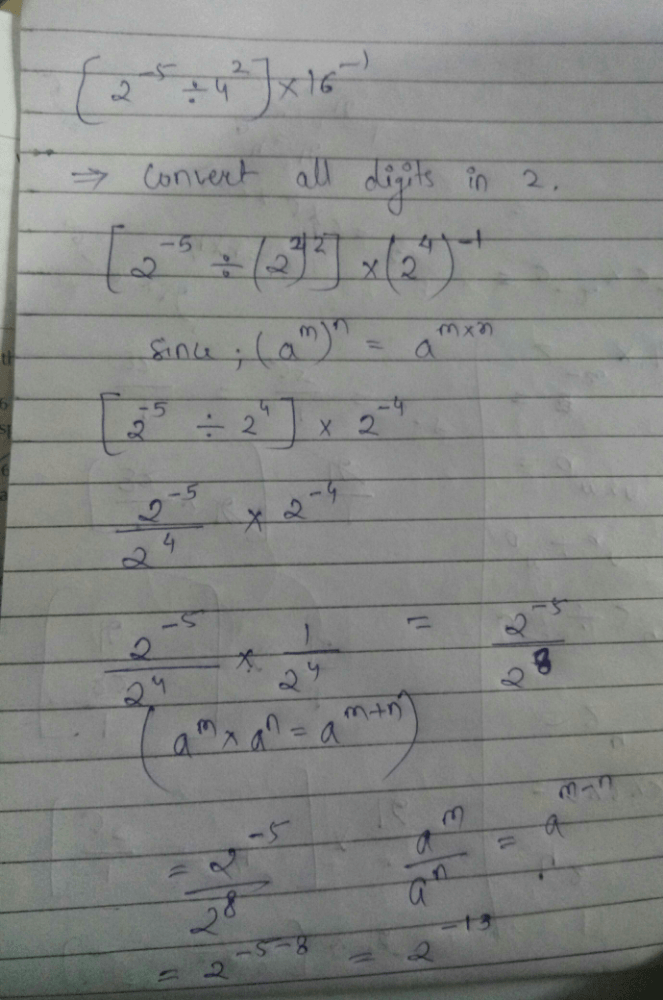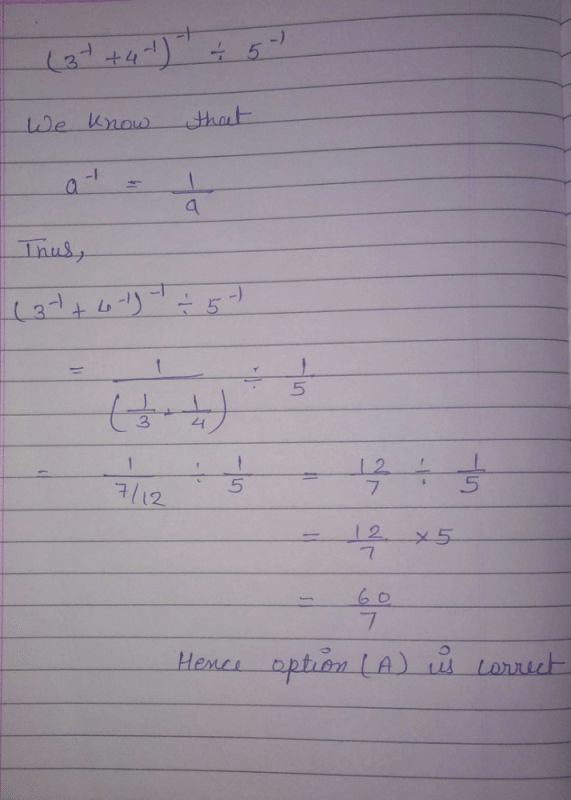All Exams >
CLAT >
Weekly Test for CLAT UG >
All Questions
All questions of Week 7 for CLAT Exam
Directions : Study the following and answer the questions given below: (i) Five persons A, B, C, D and E are sitting in a circle and their faces are towards the centre.(ii) D is between B and C.(iii) B is to the left of E.Q. Who is sitting between ‘A’ and ‘B’?- a)C
- b)D
- c)E
- d)Can’t say
Correct answer is option 'C'. Can you explain this answer?
Directions : Study the following and answer the questions given below:
(i) Five persons A, B, C, D and E are sitting in a circle and their faces are towards the centre.
(ii) D is between B and C.
(iii) B is to the left of E.
Q. Who is sitting between ‘A’ and ‘B’?
a)
C
b)
D
c)
E
d)
Can’t say

|
KS Coaching Center answered |
The correct option is c.
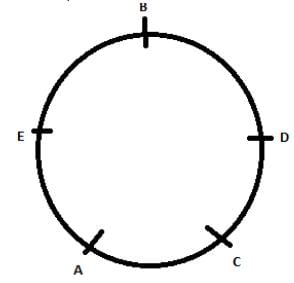
Directions : These questions are based on the following information: Eight persons L, M, N, P, Q, R, S and T sitting around a circular table facing the centre. Q is not the neighbour of P or R. M is second to the left of T and third to the right of P. R is third to the left of N, who is to the immediate left of T. L is second to the right of P.Q. Which of the following pairs of persons represents the neighbours of T?- a)MN
- b)QS
- c)RP
- d)None of these
Correct answer is option 'D'. Can you explain this answer?
Directions : These questions are based on the following information:
Eight persons L, M, N, P, Q, R, S and T sitting around a circular table facing the centre. Q is not the neighbour of P or R. M is second to the left of T and third to the right of P. R is third to the left of N, who is to the immediate left of T. L is second to the right of P.
Q. Which of the following pairs of persons represents the neighbours of T?
a)
MN
b)
QS
c)
RP
d)
None of these
|
|
Ashwini bajaj answered |
Given Information:
- Eight persons L, M, N, P, Q, R, S, and T are sitting around a circular table facing the center.
- Q is not the neighbor of P or R.
- M is second to the left of T and third to the right of P.
- R is third to the left of N, who is to the immediate left of T.
- L is second to the right of P.
To Find: The neighbors of T
Solution:
- We can start by drawing a diagram to represent the given information. Let's assume that T is at the top of the circle and draw the other persons around it:
```
R
N T P
S M
Q L
```
- From the given information, we know that:
- Q is not the neighbor of P or R. So, Q cannot be sitting next to T.
- M is second to the left of T and third to the right of P. So, P must be sitting between M and T. Also, since there are only eight persons, M cannot be sitting next to T. Therefore, P must be sitting next to T, and M must be sitting opposite to T.
- R is third to the left of N, who is to the immediate left of T. So, R must be sitting next to T, and N must be sitting opposite to T.
- L is second to the right of P. So, L must be sitting two places clockwise from T.
- Based on the above deductions, we can fill in the remaining positions:
```
R
N T P
S L M
Q |
-------
```
- Now, we can see that the neighbors of T are N and P. So, the correct answer is option D, "None of these".
Therefore, option D is the correct answer.
- Eight persons L, M, N, P, Q, R, S, and T are sitting around a circular table facing the center.
- Q is not the neighbor of P or R.
- M is second to the left of T and third to the right of P.
- R is third to the left of N, who is to the immediate left of T.
- L is second to the right of P.
To Find: The neighbors of T
Solution:
- We can start by drawing a diagram to represent the given information. Let's assume that T is at the top of the circle and draw the other persons around it:
```
R
N T P
S M
Q L
```
- From the given information, we know that:
- Q is not the neighbor of P or R. So, Q cannot be sitting next to T.
- M is second to the left of T and third to the right of P. So, P must be sitting between M and T. Also, since there are only eight persons, M cannot be sitting next to T. Therefore, P must be sitting next to T, and M must be sitting opposite to T.
- R is third to the left of N, who is to the immediate left of T. So, R must be sitting next to T, and N must be sitting opposite to T.
- L is second to the right of P. So, L must be sitting two places clockwise from T.
- Based on the above deductions, we can fill in the remaining positions:
```
R
N T P
S L M
Q |
-------
```
- Now, we can see that the neighbors of T are N and P. So, the correct answer is option D, "None of these".
Therefore, option D is the correct answer.
Directions : Study the following information and answer the questions given below: M, N, P, R, T, W, F and H are sitting around a circle facing the centre. P is third to the left of M and second to the right of T. N is second to the right of P. R is second to the right of W, who is second to the right of M. F is not an immediate neighbour of P.Q. Who is to the immediate left of R?- a)P
- b)H
- c)W
- d)T
Correct answer is option 'D'. Can you explain this answer?
Directions : Study the following information and answer the questions given below:
M, N, P, R, T, W, F and H are sitting around a circle facing the centre. P is third to the left of M and second to the right of T. N is second to the right of P. R is second to the right of W, who is second to the right of M. F is not an immediate neighbour of P.
Q. Who is to the immediate left of R?
a)
P
b)
H
c)
W
d)
T
|
|
Kiran Reddy answered |
The arrangement will be
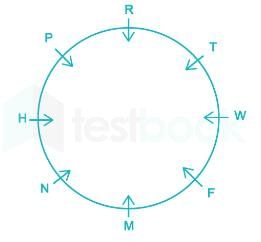
T is to the immediate left of R
Six friends A, B, C, D, E and F are sitting in a closed circle facing the centre. A is facing D.C is between A and B.F is between E and A. Who is to the immediate left of B?
- a)A
- b)C
- c)D
- d)Either C or D
Correct answer is option 'D'. Can you explain this answer?
Six friends A, B, C, D, E and F are sitting in a closed circle facing the centre. A is facing D.C is between A and B.F is between E and A. Who is to the immediate left of B?
a)
A
b)
C
c)
D
d)
Either C or D
|
|
Kiran Reddy answered |
The arrangement will be
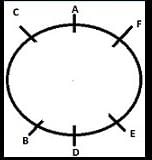
Directions : Study the following information and answer the questions given below:M, N, P, R, T, W, F and H are sitting around a circle facing the centre. P is third to the left of M and second to the right of T. N is second to the right of P. R is second to the right of W, who is second to the right of M. F is not an immediate neighbour of P.Q.
In which of the following is the first person sitting in between the second and the third person?- a)NHM
- b)PHN
- c)TRP
- d)TWF
Correct answer is option 'A'. Can you explain this answer?
Directions : Study the following information and answer the questions given below:
M, N, P, R, T, W, F and H are sitting around a circle facing the centre. P is third to the left of M and second to the right of T. N is second to the right of P. R is second to the right of W, who is second to the right of M. F is not an immediate neighbour of P.
Q.
In which of the following is the first person sitting in between the second and the third person?
In which of the following is the first person sitting in between the second and the third person?
a)
NHM
b)
PHN
c)
TRP
d)
TWF
|
|
Faizan Khan answered |
The arrangement will be
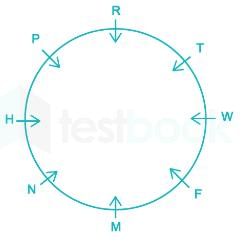
So, H is the first person sitting in between the second and the third person
Directions : Study the following and answer the questions given below: (i) Six persons Raj, Ram, Rajesh, Ramesh, Rohit and Ravi are sitting in a circle and their faces are is towards the circle.(ii) Ravi is to the left of Ram and is opposite of Ramesh.(iii) Rajesh is to right of Rohit.Q. Who is sitting between Rohit and Raj?- a)Ravi
- b)Raj
- c)Rajesh
- d)Ramesh
Correct answer is option 'D'. Can you explain this answer?
Directions : Study the following and answer the questions given below:
(i) Six persons Raj, Ram, Rajesh, Ramesh, Rohit and Ravi are sitting in a circle and their faces are is towards the circle.
(ii) Ravi is to the left of Ram and is opposite of Ramesh.
(iii) Rajesh is to right of Rohit.
Q. Who is sitting between Rohit and Raj?
a)
Ravi
b)
Raj
c)
Rajesh
d)
Ramesh
|
|
Kiran Reddy answered |
The arrangement will be
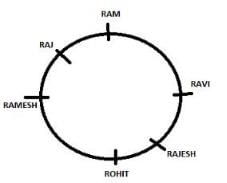
Ramesh is sitting between Rohit and Raj.
Directions : Study the following and answer the questions given below:(i) Six person L, K, M, N, O and H are sitting in a circle and their faces are towards the centre.(ii) K is between ‘O’ and ‘L’, and O is at the opposite side of H.(iii) N is to the left of ‘O’Q.
Who is sitting at the left of K?- a)L
- b)H
- c)N
- d)O
Correct answer is option 'D'. Can you explain this answer?
Directions : Study the following and answer the questions given below:
(i) Six person L, K, M, N, O and H are sitting in a circle and their faces are towards the centre.
(ii) K is between ‘O’ and ‘L’, and O is at the opposite side of H.
(iii) N is to the left of ‘O’
Q.
Who is sitting at the left of K?
Who is sitting at the left of K?
a)
L
b)
H
c)
N
d)
O
|
|
Anaya Patel answered |
The arrangement will be
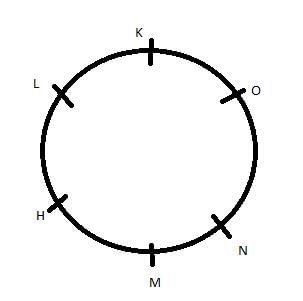
O is sitting at the left of K.
Directions : Study the following information and answer the questions given below: M, N, P, R, T, W, F and H are sitting around a circle facing the centre. P is third to the left of M and second to the right of T. N is second to the right of P. R is second to the right of W, who is second to the right of M. F is not an immediate neighbour of P.Q. Who is to third to the right of H?- a)T
- b)W
- c)R
- d)F
Correct answer is option 'D'. Can you explain this answer?
Directions : Study the following information and answer the questions given below:
M, N, P, R, T, W, F and H are sitting around a circle facing the centre. P is third to the left of M and second to the right of T. N is second to the right of P. R is second to the right of W, who is second to the right of M. F is not an immediate neighbour of P.
Q. Who is to third to the right of H?
a)
T
b)
W
c)
R
d)
F
|
|
Kiran Reddy answered |
The arrangement will be
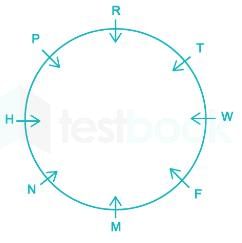
F is to third to the right of H
Directions : Study the following and answer the questions given below: (i) Six person L, K, M, N, O and H are sitting in a circle and their faces are towards the centre.(ii) K is between ‘O’ and ‘L’, and O is at the opposite side of H.(iii) N is to the left of ‘O’Q. Who is sitting between O and M?- a)L
- b)H
- c)N
- d)K
Correct answer is option 'C'. Can you explain this answer?
Directions : Study the following and answer the questions given below:
(i) Six person L, K, M, N, O and H are sitting in a circle and their faces are towards the centre.
(ii) K is between ‘O’ and ‘L’, and O is at the opposite side of H.
(iii) N is to the left of ‘O’
Q. Who is sitting between O and M?
a)
L
b)
H
c)
N
d)
K
|
|
Kiran Reddy answered |
The arrangement will be
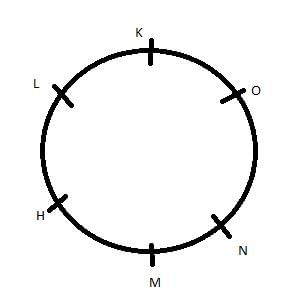
So N is sitting between O and M.
Directions : Read the following information carefully and answer the questions given below it:A, B, C, D, E and F are seated in a circle facing the centre. D is between F and B. A is second to the left of D and second to the right of E.Q. Who among following is facing D?- a)A
- b)C
- c)E
- d)Cannot be determined
Correct answer is option 'B'. Can you explain this answer?
Directions : Read the following information carefully and answer the questions given below it:
A, B, C, D, E and F are seated in a circle facing the centre. D is between F and B. A is second to the left of D and second to the right of E.
Q. Who among following is facing D?
a)
A
b)
C
c)
E
d)
Cannot be determined
|
|
Dia Mehta answered |
The arrangement wil be
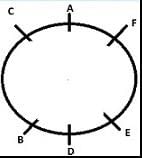
Directions : (i) A, B, C, D, E, F, G AND H are sitting along a circle facing the centre.(ii) D is the neighbour of A but not of H.(iii) B is the neighbour of F and 4th to the left of D.(iv) E is the neighbour of H and 3rd to the right of F.(v) C is neither the neighbour of A nor of G.Q. Which of the following is correct?- a)D is to the immediate left of G.
- b)A is between C and D.
- c)F is 4th to the right of D.
- d)None is correct
Correct answer is option 'D'. Can you explain this answer?
Directions :
(i) A, B, C, D, E, F, G AND H are sitting along a circle facing the centre.
(ii) D is the neighbour of A but not of H.
(iii) B is the neighbour of F and 4th to the left of D.
(iv) E is the neighbour of H and 3rd to the right of F.
(v) C is neither the neighbour of A nor of G.
Q. Which of the following is correct?
a)
D is to the immediate left of G.
b)
A is between C and D.
c)
F is 4th to the right of D.
d)
None is correct
|
|
Kiran Reddy answered |
The arrangement wil be
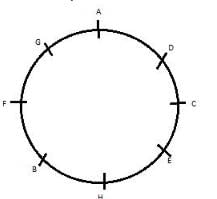
Directions : Study the following information carefully and answer the questions. A, B, C, D, E, F, G and H are sitting around a circle, facing the centre. A sits fourth to the right of H while second to the left of F. C is not the neighbor of F and B. D sits third to the right of C. H never sits next to G.Who amongst the following sits between B and D?- a)G
- b)F
- c)H
- d)None of these
Correct answer is option 'B'. Can you explain this answer?
Directions : Study the following information carefully and answer the questions. A, B, C, D, E, F, G and H are sitting around a circle, facing the centre. A sits fourth to the right of H while second to the left of F. C is not the neighbor of F and B. D sits third to the right of C. H never sits next to G.
Who amongst the following sits between B and D?
a)
G
b)
F
c)
H
d)
None of these
|
|
Sheetal iyer answered |
Given information:
A, B, C, D, E, F, G and H are sitting around a circle, facing the centre.
A sits fourth to the right of H while second to the left of F.
C is not the neighbor of F and B.
D sits third to the right of C.
H never sits next to G.
To find: Who amongst the following sits between B and D?
Solution:
1. Draw a circle and mark 8 points on it to represent A, B, C, D, E, F, G, and H sitting around it facing the center.
2. Use the given information to arrange the positions of the people around the circle:
- A sits fourth to the right of H, so we can place A and H on opposite sides of the circle with 4 other people in between them.
- A is also second to the left of F, so F must be sitting next to A (on the left side of A).
- C is not the neighbor of F and B, so B and C cannot be sitting next to F or each other. Thus, B and C must be sitting on opposite sides of the circle.
- D sits third to the right of C, so we can place C and D on opposite sides of the circle with 2 other people in between them.
- H never sits next to G, so G cannot be sitting next to H.
3. The circle should now look like this:
G - - - - - - - - - H - - - - - - - - - A - - - - - - - - - F - - - - - - - - - E
| |
| |
| |
| |
F B - - - - - - - - - C
| |
| |
| |
| |
E - - - - - - - - - D - - - - - - - - - - - - - - - - - - - - - - - - - - -
4. To find who is sitting between B and D, we look for the two people sitting on either side of D and B. D is next to E and C, and B is next to C and A. Thus, the person sitting between B and D is C.
Answer: Option B (F)
A, B, C, D, E, F, G and H are sitting around a circle, facing the centre.
A sits fourth to the right of H while second to the left of F.
C is not the neighbor of F and B.
D sits third to the right of C.
H never sits next to G.
To find: Who amongst the following sits between B and D?
Solution:
1. Draw a circle and mark 8 points on it to represent A, B, C, D, E, F, G, and H sitting around it facing the center.
2. Use the given information to arrange the positions of the people around the circle:
- A sits fourth to the right of H, so we can place A and H on opposite sides of the circle with 4 other people in between them.
- A is also second to the left of F, so F must be sitting next to A (on the left side of A).
- C is not the neighbor of F and B, so B and C cannot be sitting next to F or each other. Thus, B and C must be sitting on opposite sides of the circle.
- D sits third to the right of C, so we can place C and D on opposite sides of the circle with 2 other people in between them.
- H never sits next to G, so G cannot be sitting next to H.
3. The circle should now look like this:
G - - - - - - - - - H - - - - - - - - - A - - - - - - - - - F - - - - - - - - - E
| |
| |
| |
| |
F B - - - - - - - - - C
| |
| |
| |
| |
E - - - - - - - - - D - - - - - - - - - - - - - - - - - - - - - - - - - - -
4. To find who is sitting between B and D, we look for the two people sitting on either side of D and B. D is next to E and C, and B is next to C and A. Thus, the person sitting between B and D is C.
Answer: Option B (F)
Directions : (i) A, B, C, D, E, F, G AND H are sitting along a circle facing the centre(ii) D is the neighbour of A but not of H.(iii) B is the neighbour of F and 4th to the left of D.(iv) E is the neighbour of H and 3rd to the right of F.(v) C is neither the neighbour of A nor of G.Q. Which of the following groups has the 2nd person sitting between the 1st and the 3rd?a)AFCb)HFBc)BEHd)GADCorrect answer is option 'D'. Can you explain this answer?
(iii) B is the neighbour of F and 4th to the left of D.
(iv) E is the neighbour of H and 3rd to the right of F.
(v) C is neither the neighbour of A nor of G.
Q. Which of the following groups has the 2nd person sitting between the 1st and the 3rd?
a)AFC
b)HFB
c)BEH
d)GAD
Correct answer is option 'D'. Can you explain this answer?

|
Manoj Ghosh answered |
Directions : Study the following and answer the questions given below: (i) Five persons A, B, C, D and E are sitting in a circle and their faces are towards the centre.(ii) D is between B and C.(iii) B is to the left of E.Q. Who is to the right of ‘E’?- a)A
- b)B
- c)C
- d)D
Correct answer is option 'A'. Can you explain this answer?
Directions : Study the following and answer the questions given below:
(i) Five persons A, B, C, D and E are sitting in a circle and their faces are towards the centre.
(ii) D is between B and C.
(iii) B is to the left of E.
Q. Who is to the right of ‘E’?
a)
A
b)
B
c)
C
d)
D
|
|
Anaya Patel answered |
In this circle ,
B is extreme left to E, E is extreme left to A, A is extreme left to C ,C is extreme left to D ,
as well as D is extreme left to B .
So , the 2nd line means that A is extreme right of E.
That's why,
A is the right answer.
B is extreme left to E, E is extreme left to A, A is extreme left to C ,C is extreme left to D ,
as well as D is extreme left to B .
So , the 2nd line means that A is extreme right of E.
That's why,
A is the right answer.
Directions : Study the following information and answer the questions given below:M, N, P, R, T, W, F and H are sitting around a circle facing the centre. P is third to the left of M and second to the right of T. N is second to the right of P. R is second to the right of W, who is second to the right of M. F is not an immediate neighbour of P.Q.
Who is second to the right of F?- a)H
- b)R
- c)T
- d)Data inadequate
Correct answer is option 'C'. Can you explain this answer?
Directions : Study the following information and answer the questions given below:
M, N, P, R, T, W, F and H are sitting around a circle facing the centre. P is third to the left of M and second to the right of T. N is second to the right of P. R is second to the right of W, who is second to the right of M. F is not an immediate neighbour of P.
Q.
Who is second to the right of F?
Who is second to the right of F?
a)
H
b)
R
c)
T
d)
Data inadequate
|
|
Aryan Khanna answered |
The arrangement will be
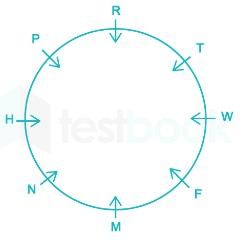
T is second to the right of F.
If  , the value of x is
, the value of x is- a)0
- b)-2
- c)1
- d)2
Correct answer is option 'D'. Can you explain this answer?
If  , the value of x is
, the value of x is
a)
0
b)
-2
c)
1
d)
2
|
|
Mehak Jaju answered |
2^3x-1+10= 7×6
2^3x-1= 42-10
2^3x-1=32
2^3x-1=2^5
3x-1=5
3x=6
x=2
2^3x-1= 42-10
2^3x-1=32
2^3x-1=2^5
3x-1=5
3x=6
x=2
Directions : (i) A, B, C, D, E, F, G AND H are sitting along a circle facing the centre.(ii) D is the neighbour of A but not of H.(iii) B is the neighbour of F and 4th to the left of D.(iv) E is the neighbour of H and 3rd to the right of F.(v) C is neither the neighbour of A nor of G.Q. Which of the following pairs has three persons sitting between them?- a)CE
- b)FH
- c)DC
- d)None of these
Correct answer is option 'D'. Can you explain this answer?
Directions :
(i) A, B, C, D, E, F, G AND H are sitting along a circle facing the centre.
(ii) D is the neighbour of A but not of H.
(iii) B is the neighbour of F and 4th to the left of D.
(iv) E is the neighbour of H and 3rd to the right of F.
(v) C is neither the neighbour of A nor of G.
Q. Which of the following pairs has three persons sitting between them?
a)
CE
b)
FH
c)
DC
d)
None of these
|
|
Anaya Patel answered |
The arrangement will be
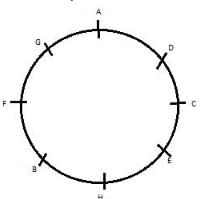
Which of the following is not equal to -27/64- a)

- b)

- c)

- d)

Correct answer is 'B'. Can you explain this answer?
Which of the following is not equal to -27/64
a)
b)
c)
d)

|
Shalini Chunukwad answered |
Answer is not (b) it is (c )
Which of the following is not equal to 1/2?- a)5 x 10-1
- b)0.5 x 10-1
- c)0.05 x 10
- d)0.005 x 102
Correct answer is option 'B'. Can you explain this answer?
Which of the following is not equal to 1/2?
a)
5 x 10-1
b)
0.5 x 10-1
c)
0.05 x 10
d)
0.005 x 102

|
Crafty Classes answered |
- After solving , we got to know that 0.5 x 10-1 will be 5/100 = 1/20 not 1/2
Hence, B is the correct ans
Hence, B is the correct ans
Directions : (i) A, B, C, D, E, F, G AND H are sitting along a circle facing the centre.(ii) D is the neighbour of A but not of H.(iii) B is the neighbour of F and 4th to the left of D.(iv) E is the neighbour of H and 3rd to the right of F.(v) C is neither the neighbour of A nor of G.Q. If C and G interchange their positions, which of the following will indicate A’s position?- a)To the immediate right of G
- b)4th to the right of C
- c)2nd to the left of G
- d)To the immediate left of C
Correct answer is option 'D'. Can you explain this answer?
Directions :
(i) A, B, C, D, E, F, G AND H are sitting along a circle facing the centre.
(ii) D is the neighbour of A but not of H.
(iii) B is the neighbour of F and 4th to the left of D.
(iv) E is the neighbour of H and 3rd to the right of F.
(v) C is neither the neighbour of A nor of G.
Q. If C and G interchange their positions, which of the following will indicate A’s position?
a)
To the immediate right of G
b)
4th to the right of C
c)
2nd to the left of G
d)
To the immediate left of C
|
|
Anaya Patel answered |
The arrangement will be
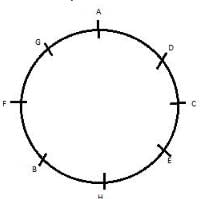
So, If C and G interchange their positions, A’s position will be to the immediate left of C
Study the following information carefully to answer these questions: Eight friends J, K, L, M, N, O, P and Q are sitting around a circle facing the centre. J is not the neighbour of N. L is third to the right of K. Q is second to the left of N who is next to the right of L. O is not the neighbour of N or K and is to the immediate left of P. Which of the following groups has the first person sitting between the other two persons ?- a)JQL
- b)PKJ
- c)QNL
- d)None of these
Correct answer is option 'D'. Can you explain this answer?
Study the following information carefully to answer these questions: Eight friends J, K, L, M, N, O, P and Q are sitting around a circle facing the centre. J is not the neighbour of N. L is third to the right of K. Q is second to the left of N who is next to the right of L. O is not the neighbour of N or K and is to the immediate left of P.
Which of the following groups has the first person sitting between the other two persons ?
a)
JQL
b)
PKJ
c)
QNL
d)
None of these
|
|
Kiran Reddy answered |
- Eight friends J, K, L, M N, O, P and Q are sitting around a circle facing the center.
- J is not the neighbour of N.
- L is third to the right of K.
- Q is second to the left of N who is next to the right of L.
- O is not the neighbour of N or K and is to the immediate left of P.
So, the first person sitting between the other two persons is:
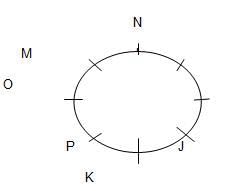

Directions : On the basis of the information given below, carefully answer the questions: - P, Q, R, S, T, U and V are sitting around a circular table facing the centre
- R is next to the left of U and V is second to the left of R.
- P is sitting third to the left of T.
- Q is between S and T.
Q. Which of the following is false?- a)U is third to the right of S.
- b)U is to the immediate right of R
- c)P is fourth to the right of T
- d) Q is to the immediate left of S.
Correct answer is option 'A'. Can you explain this answer?
Directions : On the basis of the information given below, carefully answer the questions:
- P, Q, R, S, T, U and V are sitting around a circular table facing the centre
- R is next to the left of U and V is second to the left of R.
- P is sitting third to the left of T.
- Q is between S and T.
Q. Which of the following is false?
a)
U is third to the right of S.
b)
U is to the immediate right of R
c)
P is fourth to the right of T
d)
Q is to the immediate left of S.
|
|
Anaya Patel answered |
The arrangement will be
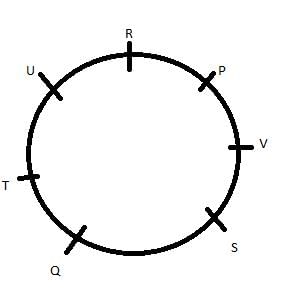
Directions : Study the following and answer the questions given below:(i) Six persons Raj, Ram, Rajesh, Ramesh, Rohit and Ravi are sitting in a circle and their faces are is towards the circle.(ii) Ravi is to the left of Ram and is opposite of Ramesh.(iii) Rajesh is to right of Rohit.Q.
Who is to the left of Ramesh?- a)Ravi
- b)Raj
- c)Rajesh
- d)Ram
Correct answer is option 'B'. Can you explain this answer?
Directions : Study the following and answer the questions given below:
(i) Six persons Raj, Ram, Rajesh, Ramesh, Rohit and Ravi are sitting in a circle and their faces are is towards the circle.
(ii) Ravi is to the left of Ram and is opposite of Ramesh.
(iii) Rajesh is to right of Rohit.
Q.
Who is to the left of Ramesh?
Who is to the left of Ramesh?
a)
Ravi
b)
Raj
c)
Rajesh
d)
Ram
|
|
Anaya Patel answered |
The correct option is B.
It is clear from the given image.
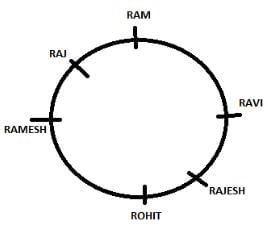
Principle: Any direct physical interference with the goods in somebody's possession without lawful justification is called trespass to goods.
Fact: A purchased a car from a person who had no title to it and had sent it to a garage for repair. X, believing, wrongly, that the car was his, removed it from the garage. - a)X cannot be held responsible for trespass to good as he was under a wrong belief.
- b)X can be held responsible for trespass to goods.
- c)X has not committed any wrong.
- d)None of the above.
Correct answer is option 'B'. Can you explain this answer?
Principle: Any direct physical interference with the goods in somebody's possession without lawful justification is called trespass to goods.
Fact: A purchased a car from a person who had no title to it and had sent it to a garage for repair. X, believing, wrongly, that the car was his, removed it from the garage.
Fact: A purchased a car from a person who had no title to it and had sent it to a garage for repair. X, believing, wrongly, that the car was his, removed it from the garage.
a)
X cannot be held responsible for trespass to good as he was under a wrong belief.
b)
X can be held responsible for trespass to goods.
c)
X has not committed any wrong.
d)
None of the above.
|
|
Aryan Khanna answered |
Under section 441 of IPC which defines Criminal trespass that whoever enters into or upon property in the possession of another with intent to commit an offence or to intimidate, insult or annoy any person in possession of such property or having lawfully entered into or upon such property, unlawfully remains there with the intent thereby to intimidate, insult or annoy any such person or with intent to commit an offence.
Civilisation means outward….(21)… whereas culture means inward perfection. We may be…(22)...today, but we are not cultured. We have trains, aeroplanes and all the modern modes and ….(23).. . This is…(24)…on the road of materialism but we have lost our finer emotions. Civilisation has…..(25)…mystery and romance out of the heart of nature and …..(26)… her beauty and magic. It has placed…..(27)….power in the hands of man, making him a….(28)….. With a single atom or hydrogen bomb, he can rain death and ..(29)…… in millions of innocent creatures. Thus, he is out to….(30)…..himself with his own hands.Q. Find the word most appropriate for Blank No. 29- a)destruction
- b)dearth
- c)gloom
- d)sadness
Correct answer is option 'B'. Can you explain this answer?
Civilisation means outward….(21)… whereas culture means inward perfection. We may be…(22)...today, but we are not cultured. We have trains, aeroplanes and all the modern modes and ….(23).. . This is…(24)…on the road of materialism but we have lost our finer emotions. Civilisation has…..(25)…mystery and romance out of the heart of nature and …..(26)… her beauty and magic. It has placed…..(27)….power in the hands of man, making him a….(28)….. With a single atom or hydrogen bomb, he can rain death and ..(29)…… in millions of innocent creatures. Thus, he is out to….(30)…..himself with his own hands.
Q. Find the word most appropriate for Blank No. 29
a)
destruction
b)
dearth
c)
gloom
d)
sadness
|
|
Dia Mehta answered |
B is the correct option. Dearth means scarcity or lack of something.
so according to the sentence hydrogen bomb can lead to lack of small and innocent creatures like microorganisms, etc.
so according to the sentence hydrogen bomb can lead to lack of small and innocent creatures like microorganisms, etc.
Principle:
I. An Interference with the use of the property of another person is nuisance.
II. To constitute a tort, an act or an omission must result in the violation of a legal right vested in the plaintiff.
Facts:
Vinay and Navin were old friends and had recently started living next door to each other. Navin cooked delicious steak on barbecue, and Vinay was a fan of Navin’s cooking. Therefore, when it was Vinay’s birthday, he requested Navin to cook the steak for him. Navin agreed happily. However, when he started cooking, the smoke from the barbeque was blown by wind straight into Vinay’s house. Vinay felt nauseated and had to leave the house and stay out all night. Is Navin liable for nuisance?
- a)No, because Vinay asked Navin to prepare steak for him.
- b)Yes, because blowing smoke from a barbeque into another’s house and the smoke causing discomfort is a foreseeable situation.
- c)Yes, because Navin’s act interfered with Vinay’s use of property.
- d)No, because Navin did not know that Vinay would have such a reaction to smoke from barbeque.
Correct answer is option 'A'. Can you explain this answer?
Principle:
I. An Interference with the use of the property of another person is nuisance.
II. To constitute a tort, an act or an omission must result in the violation of a legal right vested in the plaintiff.
I. An Interference with the use of the property of another person is nuisance.
II. To constitute a tort, an act or an omission must result in the violation of a legal right vested in the plaintiff.
Facts:
Vinay and Navin were old friends and had recently started living next door to each other. Navin cooked delicious steak on barbecue, and Vinay was a fan of Navin’s cooking. Therefore, when it was Vinay’s birthday, he requested Navin to cook the steak for him. Navin agreed happily. However, when he started cooking, the smoke from the barbeque was blown by wind straight into Vinay’s house. Vinay felt nauseated and had to leave the house and stay out all night. Is Navin liable for nuisance?
Vinay and Navin were old friends and had recently started living next door to each other. Navin cooked delicious steak on barbecue, and Vinay was a fan of Navin’s cooking. Therefore, when it was Vinay’s birthday, he requested Navin to cook the steak for him. Navin agreed happily. However, when he started cooking, the smoke from the barbeque was blown by wind straight into Vinay’s house. Vinay felt nauseated and had to leave the house and stay out all night. Is Navin liable for nuisance?
a)
No, because Vinay asked Navin to prepare steak for him.
b)
Yes, because blowing smoke from a barbeque into another’s house and the smoke causing discomfort is a foreseeable situation.
c)
Yes, because Navin’s act interfered with Vinay’s use of property.
d)
No, because Navin did not know that Vinay would have such a reaction to smoke from barbeque.

|
Aspire Academy answered |
The Principle is quite wide in scope and does not create a distinction between authorized and unauthorized interference with the use of property. Thus, the interference under this principle would amount to nuisance.
Principle:I. A person can be held guilty under the tort of negligence only if there is proximate cause and the damage is not too remoteII. Proximate cause means that you must be able to show that the harm was caused by the tort you are suing forIII. Proximate cause may be doubtful when a superseding intervening cause happens shortly after the injury.Facts: Bantu was playing in the school soccer field when he got hit hard by the ball in his chest by a friend. He fell unconscious and suffered severe internal injuries. His mother decided to sue for the tort of negligence.Which of the following is correct?- a) The damage to Bantu was due to proximate cause
- b) The damage to Bantu was remote
- c) The damage to Bantu was due to superseding intervening cause
- d) None of the above
Correct answer is option 'A'. Can you explain this answer?
Principle:
I. A person can be held guilty under the tort of negligence only if there is proximate cause and the damage is not too remote
II. Proximate cause means that you must be able to show that the harm was caused by the tort you are suing for
III. Proximate cause may be doubtful when a superseding intervening cause happens shortly after the injury.
Facts: Bantu was playing in the school soccer field when he got hit hard by the ball in his chest by a friend. He fell unconscious and suffered severe internal injuries. His mother decided to sue for the tort of negligence.
Which of the following is correct?
a)
The damage to Bantu was due to proximate cause
b)
The damage to Bantu was remote
c)
The damage to Bantu was due to superseding intervening cause
d)
None of the above
|
|
Aryan Khanna answered |
Going by principles I and II, it is clear that Bantu was injured as a direct result of being hit by the ball on the soccer field, and neither the cause nor the damage was too remote. Thus, it may be deduced that the damage to Bantu was due to proximate cause.
Directions: Study the following information carefully and answer the questions given below:
B, M, K, H, T, R, D, W and A are sitting around a circle facing at the centre. R is third to the right of B. H is second to the right of A who is second to the right of R. K is third to the right of T who is not an immediate neighbour of H. D is second to the left of T. M is fourth to the right of W.Q. Who is to the immediate left of D?- a)G
- b)K
- c)H
- d)M
Correct answer is option 'C'. Can you explain this answer?
Directions: Study the following information carefully and answer the questions given below:
B, M, K, H, T, R, D, W and A are sitting around a circle facing at the centre. R is third to the right of B. H is second to the right of A who is second to the right of R. K is third to the right of T who is not an immediate neighbour of H. D is second to the left of T. M is fourth to the right of W.
B, M, K, H, T, R, D, W and A are sitting around a circle facing at the centre. R is third to the right of B. H is second to the right of A who is second to the right of R. K is third to the right of T who is not an immediate neighbour of H. D is second to the left of T. M is fourth to the right of W.
Q. Who is to the immediate left of D?
a)
G
b)
K
c)
H
d)
M
|
|
Sarita bhatia answered |
Given Information:
- B, M, K, H, T, R, D, W and A are sitting around a circle facing at the centre.
- R is third to the right of B.
- H is second to the right of A who is second to the right of R.
- K is third to the right of T who is not an immediate neighbour of H.
- D is second to the left of T.
- M is fourth to the right of W.
To find: Who is to the immediate left of D?
Solution:
- We need to draw a circle and place all the given persons on it, facing towards the center.
- From the given information, we can place R at the third position to the right of B.
- A is second to the right of R, so A will be placed after R in the clockwise direction.
- H is second to the right of A, so H will be placed after A in the clockwise direction.
- T is not an immediate neighbor of H, so we can place T at any position except the two adjacent positions of H. Let's place T between B and M.
- K is third to the right of T, so K will be placed after T, three positions to the right.
- D is second to the left of T, so D will be placed before T, two positions to the left.
- M is fourth to the right of W, so M will be placed after K, four positions to the right.
- Now, we can see that the immediate left of D is H.
Therefore, the correct answer is option 'C' (H).
- B, M, K, H, T, R, D, W and A are sitting around a circle facing at the centre.
- R is third to the right of B.
- H is second to the right of A who is second to the right of R.
- K is third to the right of T who is not an immediate neighbour of H.
- D is second to the left of T.
- M is fourth to the right of W.
To find: Who is to the immediate left of D?
Solution:
- We need to draw a circle and place all the given persons on it, facing towards the center.
- From the given information, we can place R at the third position to the right of B.
- A is second to the right of R, so A will be placed after R in the clockwise direction.
- H is second to the right of A, so H will be placed after A in the clockwise direction.
- T is not an immediate neighbor of H, so we can place T at any position except the two adjacent positions of H. Let's place T between B and M.
- K is third to the right of T, so K will be placed after T, three positions to the right.
- D is second to the left of T, so D will be placed before T, two positions to the left.
- M is fourth to the right of W, so M will be placed after K, four positions to the right.
- Now, we can see that the immediate left of D is H.
Therefore, the correct answer is option 'C' (H).
Each species has its special place or habitat. An (31)____ bird watcher can look at (32)____forest, meadow, lake , swamp or field and (33)____ almost exactly what birds he (34)____find there (35)____birds are found all over the world; others (36)____ themselves to certain areas. Still (37)____migrate from one country to another in (38)____in search of warmth and (39)____, and then return in spring,(40)____the season is more favourable.Q. Find the word most appropriate for Blank No. 40- a)when
- b)after
- c)until
- d)while
Correct answer is option 'A'. Can you explain this answer?
Each species has its special place or habitat. An (31)____ bird watcher can look at (32)____forest, meadow, lake , swamp or field and (33)____ almost exactly what birds he (34)____find there (35)____birds are found all over the world; others (36)____ themselves to certain areas. Still (37)____migrate from one country to another in (38)____in search of warmth and (39)____, and then return in spring,(40)____the season is more favourable.
Q. Find the word most appropriate for Blank No. 40
a)
when
b)
after
c)
until
d)
while
|
|
Suyash Singh answered |
Habitat and Migration of Birds
Blank No. 31: Each species has its special place or habitat.
Blank No. 32: forest, meadow, lake, swamp, or field
Blank No. 33: predict
Blank No. 34: can
Blank No. 35: Some
Blank No. 36: restrict
Blank No. 37: others
Blank No. 38: order
Blank No. 39: food
Blank No. 40: when
Birds have a special place or habitat where they live and thrive. A bird watcher can predict the variety of birds that he can find in a particular habitat such as a forest, meadow, lake, swamp or field. Some birds are found all over the world, while others restrict themselves to certain areas. Some birds migrate from one country to another in order to search for warmth and food, and then return in spring when the season is more favorable.
Conclusion:
Birds are fascinating creatures that have adapted well to their unique habitats. They are found all over the world, each in their own special place. Some species migrate to warmer areas in search of food and warmth, while others restrict themselves to specific areas. A bird watcher can predict the variety of birds that he can find in a particular habitat, making bird watching an exciting and rewarding hobby.
Blank No. 31: Each species has its special place or habitat.
Blank No. 32: forest, meadow, lake, swamp, or field
Blank No. 33: predict
Blank No. 34: can
Blank No. 35: Some
Blank No. 36: restrict
Blank No. 37: others
Blank No. 38: order
Blank No. 39: food
Blank No. 40: when
Birds have a special place or habitat where they live and thrive. A bird watcher can predict the variety of birds that he can find in a particular habitat such as a forest, meadow, lake, swamp or field. Some birds are found all over the world, while others restrict themselves to certain areas. Some birds migrate from one country to another in order to search for warmth and food, and then return in spring when the season is more favorable.
Conclusion:
Birds are fascinating creatures that have adapted well to their unique habitats. They are found all over the world, each in their own special place. Some species migrate to warmer areas in search of food and warmth, while others restrict themselves to specific areas. A bird watcher can predict the variety of birds that he can find in a particular habitat, making bird watching an exciting and rewarding hobby.
Principle: Nuisance as a tort (civil wrong) means an unlawful interference with a person's use or enjoyment of land, or some right over, or in connection with it.
Fact: During the scarcity of onions, long queues were made outside the defendant's shop who having a license to sell fruits and vegetables used to sell only 1 Kg. of onion per ration card. The queues extended on to the highway and also caused some obstruction to the neighboring shops. The neighboring shopkeepers brought an action for nuisance against the defendant. - a)The defendant was not liable for nuisance
- b)The defendant was liable under the principle of strict liability
- c)The defendant is liable for nuisance
- d)The plaintiff's suit should be decreed in his favour
Correct answer is option 'C'. Can you explain this answer?
Principle: Nuisance as a tort (civil wrong) means an unlawful interference with a person's use or enjoyment of land, or some right over, or in connection with it.
Fact: During the scarcity of onions, long queues were made outside the defendant's shop who having a license to sell fruits and vegetables used to sell only 1 Kg. of onion per ration card. The queues extended on to the highway and also caused some obstruction to the neighboring shops. The neighboring shopkeepers brought an action for nuisance against the defendant.
Fact: During the scarcity of onions, long queues were made outside the defendant's shop who having a license to sell fruits and vegetables used to sell only 1 Kg. of onion per ration card. The queues extended on to the highway and also caused some obstruction to the neighboring shops. The neighboring shopkeepers brought an action for nuisance against the defendant.
a)
The defendant was not liable for nuisance
b)
The defendant was liable under the principle of strict liability
c)
The defendant is liable for nuisance
d)
The plaintiff's suit should be decreed in his favour
|
|
Eshaan Kapoor answered |
The defendant is liable for nuisance as it was his duty to manage the queues of customers that was effecting the neighbouring shops. Nuisance, in law, is a human action or a physical condition that is destructive or hostile to other people and offers ascend to a reason for the activity. An open irritation made in an open spot or on open land, or influencing the ethics, security, or soundness of the network, is viewed as an offence against the state.
Directions : On the basis of the information given below, carefully answer the questions:(i) P, Q, R, S and T are sitting in a circle facing the centre.(ii) R is immediate left of T.(iii) P is between S and T.Q.
Who is to the immediate left of R?- a)P
- b)Q
- c)S
- d)T
Correct answer is option 'B'. Can you explain this answer?
Directions : On the basis of the information given below, carefully answer the questions:
(i) P, Q, R, S and T are sitting in a circle facing the centre.
(ii) R is immediate left of T.
(iii) P is between S and T.
Q.
Who is to the immediate left of R?
Who is to the immediate left of R?
a)
P
b)
Q
c)
S
d)
T
|
|
Anaya Patel answered |
The arrangement will be
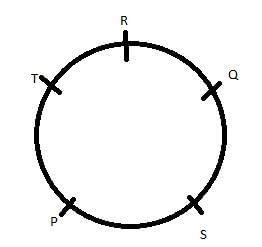
Q is to the immediate left of R
Principle: Whoever stores a substance that could potentially cause damage on escape shall be absolutely liable for any damage caused by the escape of such substance from its premises. The person will be liable for the tort of negligence. Facts: Prerna and Anurag decide to buy a mini- chemical capsule for their scientific experiments. The minuscule capsule has great potentiality for damage if broken, and hence Prerna and Anurag take complete precautions against that. However, one day the capsule breaks due to an earthquake. Their neighbour, Bajaj, rushes into their premises to check what caused the loud sound that accompanied the breakage of the object. Prerna and Anurag ensure that the damage is contained within the premises of the room. However, their neighbour, Bajaj, sues them for the damage caused to him due to contact with the toxic object.- a)Bajaj was responsible for entering their premises and cannot sue Prerna or Anurag for his stupidity.
- b)The object did not escape the premises, and hence Prerna and Anurag would not be liable.
- c)The act of keeping a dangerous object would in itself make Prerna and Anurag absolutely liable.
- d)None of the above.
Correct answer is option 'B'. Can you explain this answer?
Principle: Whoever stores a substance that could potentially cause damage on escape shall be absolutely liable for any damage caused by the escape of such substance from its premises. The person will be liable for the tort of negligence.
Facts: Prerna and Anurag decide to buy a mini- chemical capsule for their scientific experiments. The minuscule capsule has great potentiality for damage if broken, and hence Prerna and Anurag take complete precautions against that. However, one day the capsule breaks due to an earthquake. Their neighbour, Bajaj, rushes into their premises to check what caused the loud sound that accompanied the breakage of the object. Prerna and Anurag ensure that the damage is contained within the premises of the room. However, their neighbour, Bajaj, sues them for the damage caused to him due to contact with the toxic object.
a)
Bajaj was responsible for entering their premises and cannot sue Prerna or Anurag for his stupidity.
b)
The object did not escape the premises, and hence Prerna and Anurag would not be liable.
c)
The act of keeping a dangerous object would in itself make Prerna and Anurag absolutely liable.
d)
None of the above.
|
|
Radhika Koli answered |
According to the principal the person would be liable for the damage caused by a dangerous substance owned by him/her if it was because of their own negligence. But as stated In the question , Damage was caused because of the Act of God i.e Earthquake. Act of God is something which is beyond human control.
Therefore, Prerna and Anurag would not be liable since the damage caused was not because of their negligence but Act of God.
I hope this clears your doubt .
Therefore, Prerna and Anurag would not be liable since the damage caused was not because of their negligence but Act of God.
I hope this clears your doubt .
The square of  is
is- a)

- b)3/5
- c)-9/25
- d)9/25
Correct answer is option 'D'. Can you explain this answer?
The square of  is
is
a)
b)
3/5
c)
-9/25
d)
9/25
|
|
Aarav Sharma answered |
The square of a number is obtained by multiplying the number by itself. In this case, we need to find the square of -3/5.
To calculate the square of a fraction, we square both the numerator and the denominator separately. So, the square of -3/5 can be calculated as (-3/5)^2.
To simplify the calculation, we can write -3/5 as a fraction with positive numerator and denominator by multiplying both numerator and denominator by -1. This gives us (-1*-3)/(-1*5) = 3/5.
Now, we can square 3/5. Squaring the numerator gives us (3^2) = 9, and squaring the denominator gives us (5^2) = 25.
So, the square of -3/5 is (3/5)^2 = 9/25.
Therefore, the correct answer is option D) 9/25.
To calculate the square of a fraction, we square both the numerator and the denominator separately. So, the square of -3/5 can be calculated as (-3/5)^2.
To simplify the calculation, we can write -3/5 as a fraction with positive numerator and denominator by multiplying both numerator and denominator by -1. This gives us (-1*-3)/(-1*5) = 3/5.
Now, we can square 3/5. Squaring the numerator gives us (3^2) = 9, and squaring the denominator gives us (5^2) = 25.
So, the square of -3/5 is (3/5)^2 = 9/25.
Therefore, the correct answer is option D) 9/25.
Principle:I. Slander is any defamation that is spoken or heard.II. Libel is any defamation that can be seen like writing, printing, movie, statue etc.Facts: Meeta and Reeta are both popular actresses in the Hindi film industry. They were the best of friends. However, when Meeta was replaced by Reeta in a film, she came on the sets of the film and interrupted the shooting. She started ranting on how Reeta used to pay directors and producers in order to compel them to cast her. Following this public outburst, Reeta lost out on major endorsement deals as companies were apprehensive about her damaged reputation.- a) Reeta can sue Meeta for libel.
- b) Reeta can sue Meeta for slander.
- c) Reeta cannot sue Meeta for none of the statements made by Meeta were published.
- d) Reeta can sue Meeta for a criminal wrong
Correct answer is option 'B'. Can you explain this answer?
Principle:
I. Slander is any defamation that is spoken or heard.
II. Libel is any defamation that can be seen like writing, printing, movie, statue etc.
Facts: Meeta and Reeta are both popular actresses in the Hindi film industry. They were the best of friends. However, when Meeta was replaced by Reeta in a film, she came on the sets of the film and interrupted the shooting. She started ranting on how Reeta used to pay directors and producers in order to compel them to cast her. Following this public outburst, Reeta lost out on major endorsement deals as companies were apprehensive about her damaged reputation.
a)
Reeta can sue Meeta for libel.
b)
Reeta can sue Meeta for slander.
c)
Reeta cannot sue Meeta for none of the statements made by Meeta were published.
d)
Reeta can sue Meeta for a criminal wrong
|
|
Rohit Jain answered |
As per the principle given in the question, slander is a form of defamation which is spoken or heard. In the instant case, Meeta engaged in making derogatory remarks about Reeta in a public place because of which Reeta suffered professionally as well. Hence, Reeta can sue Meeta for slander.
Directions : Read the following information carefully and answer the questions given below it:A, B, C, D, E and F are seated in a circle facing the centre. D is between F and B. A is second to the left of D and second to the right of E.Q. Who is facing A?- a)B
- b)D
- c)F
- d)Either F or B
Correct answer is option 'D'. Can you explain this answer?
Directions : Read the following information carefully and answer the questions given below it:
A, B, C, D, E and F are seated in a circle facing the centre. D is between F and B. A is second to the left of D and second to the right of E.
Q. Who is facing A?
a)
B
b)
D
c)
F
d)
Either F or B

|
Manoj Ghosh answered |
Clearly, the circular arrangement is as shown :
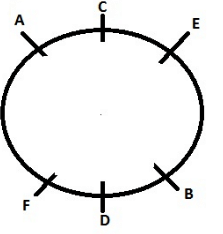
Clearly, B is facing A.
The correct answer is a. b.
Ancestors and dead relations were believed to punish…(11)… for sins, both of commission and …(12) …. . The ancestors were the guardians of….(13)…society’s morality, and they chastised those…..(14)…failed in their duty. The explanation….(15)..heard was: ‘He told lies about the ….(16)….and the ancestors killed him,’ or ’…(17).. uncle’s ghost killed him because he…(18)…. to look after his children or his…(19)… felt disgraced by his conduct, ….(20)…killed him’.Q. Find the word most appropriate for Blank no. 11- a)friends
- b)acquaintances
- c)people
- d)descendants
Correct answer is option 'D'. Can you explain this answer?
Ancestors and dead relations were believed to punish…(11)… for sins, both of commission and …(12) …. . The ancestors were the guardians of….(13)…society’s morality, and they chastised those…..(14)…failed in their duty. The explanation….(15)..heard was: ‘He told lies about the ….(16)….and the ancestors killed him,’ or ’…(17).. uncle’s ghost killed him because he…(18)…. to look after his children or his…(19)… felt disgraced by his conduct, ….(20)…killed him’.
Q. Find the word most appropriate for Blank no. 11
a)
friends
b)
acquaintances
c)
people
d)
descendants
|
|
Anshul Pillai answered |
Ancestors and dead relations were believed to punish individuals for their wrongdoings or to bring misfortune upon them. This belief was prevalent in many ancient cultures and still exists in some traditional societies today.
In these belief systems, it was thought that the spirits of deceased family members had the ability to observe the actions of the living and intervene in their lives. They were believed to have the power to cause illness, accidents, or other misfortunes as a form of punishment for immoral or unethical behavior.
The idea behind this belief was to maintain social order and ensure that individuals acted in accordance with societal norms and values. It served as a form of social control, as people were discouraged from engaging in harmful or immoral actions due to the fear of retribution from their ancestors.
Various rituals and ceremonies were performed to appease the spirits of ancestors and ensure their favor. These rituals often involved offerings, prayers, and other forms of communication with the deceased. By showing respect and reverence to their ancestors, people believed they could avoid punishment and receive blessings instead.
This belief in ancestral punishment also extended to concepts of karma and reincarnation in some cultures. It was believed that the repercussions of one's actions in this life would not only affect them but also carry over to their future lives. Therefore, behaving morally and ethically was seen as crucial for avoiding future suffering.
While these beliefs may seem outdated or superstitious to some, they continue to hold significance for many individuals and communities. They provide a sense of connection to their ancestors and serve as a reminder of the importance of living a virtuous life.
In these belief systems, it was thought that the spirits of deceased family members had the ability to observe the actions of the living and intervene in their lives. They were believed to have the power to cause illness, accidents, or other misfortunes as a form of punishment for immoral or unethical behavior.
The idea behind this belief was to maintain social order and ensure that individuals acted in accordance with societal norms and values. It served as a form of social control, as people were discouraged from engaging in harmful or immoral actions due to the fear of retribution from their ancestors.
Various rituals and ceremonies were performed to appease the spirits of ancestors and ensure their favor. These rituals often involved offerings, prayers, and other forms of communication with the deceased. By showing respect and reverence to their ancestors, people believed they could avoid punishment and receive blessings instead.
This belief in ancestral punishment also extended to concepts of karma and reincarnation in some cultures. It was believed that the repercussions of one's actions in this life would not only affect them but also carry over to their future lives. Therefore, behaving morally and ethically was seen as crucial for avoiding future suffering.
While these beliefs may seem outdated or superstitious to some, they continue to hold significance for many individuals and communities. They provide a sense of connection to their ancestors and serve as a reminder of the importance of living a virtuous life.
The angular velocity depends upon the rate of change of the _______. - a)Angular Distance
- b)Angular acceleration
- c)Angular Displacement
- d)torque
Correct answer is option 'B'. Can you explain this answer?
The angular velocity depends upon the rate of change of the _______.
a)
Angular Distance
b)
Angular acceleration
c)
Angular Displacement
d)
torque
|
|
Eshaan Kapoor answered |
The angular velocity is defined as the rate of change of angular displacement and is a vector quantity which specifies the angular speed of an object and the axis about which the object is rotating.
Directions : (i) A, B, C, D, E, F, G AND H are sitting along a circle facing the centre.(ii) D is the neighbour of A but not of H.(iii) B is the neighbour of F and 4th to the left of D.(iv) E is the neighbour of H and 3rd to the right of F.(v) C is neither the neighbour of A nor of G.Q. Which of the following is wrong?- a)B is to the immediate left of H.
- b)H is to the immediate left of E.
- c)D is 4th to the right of F.
- d)C is 4th to the right of F.
Correct answer is option 'C'. Can you explain this answer?
Directions :
(i) A, B, C, D, E, F, G AND H are sitting along a circle facing the centre.
(ii) D is the neighbour of A but not of H.
(iii) B is the neighbour of F and 4th to the left of D.
(iv) E is the neighbour of H and 3rd to the right of F.
(v) C is neither the neighbour of A nor of G.
Q. Which of the following is wrong?
a)
B is to the immediate left of H.
b)
H is to the immediate left of E.
c)
D is 4th to the right of F.
d)
C is 4th to the right of F.
|
|
Bibek Kumar answered |
The correct option is C.
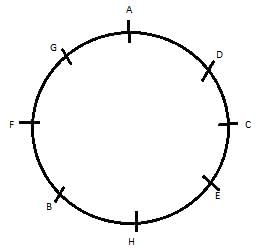
Principle:
I. Malicious prosecution under tort law, has the following ingredients:
(1) intentionally (and maliciously) instituting and pursuing (or causing to be instituted or pursued) a legal action (civil or criminal) (2) brought without probable cause and (3) dismissed in favour of the victim of the malicious prosecution.
II. There is no tort to protect innocent plaintiffs from frivolous defences raised by defendants.
Do the facts indicate a case of malicious prosecution?- a)Yes
- b)No
- c)It depends on the loss sustained by Harry due to the suit.
- d)It cannot be determined.
Correct answer is option 'A'. Can you explain this answer?
Principle:
I. Malicious prosecution under tort law, has the following ingredients:
(1) intentionally (and maliciously) instituting and pursuing (or causing to be instituted or pursued) a legal action (civil or criminal) (2) brought without probable cause and (3) dismissed in favour of the victim of the malicious prosecution.
II. There is no tort to protect innocent plaintiffs from frivolous defences raised by defendants.
Do the facts indicate a case of malicious prosecution?
I. Malicious prosecution under tort law, has the following ingredients:
(1) intentionally (and maliciously) instituting and pursuing (or causing to be instituted or pursued) a legal action (civil or criminal) (2) brought without probable cause and (3) dismissed in favour of the victim of the malicious prosecution.
II. There is no tort to protect innocent plaintiffs from frivolous defences raised by defendants.
Do the facts indicate a case of malicious prosecution?
a)
Yes
b)
No
c)
It depends on the loss sustained by Harry due to the suit.
d)
It cannot be determined.
|
|
Eshaan Kapoor answered |
As per principle (i), malicious prosecution has 3 essential elements: (1) intentionally (and maliciously) instituting and pursuing (or causing to be instituted or pursued) a legal action (civil or criminal) (2) brought without probable cause and (3) dismissed in favour of the victim of the malicious prosecution. Since all three of these were present in the instant case, thus, a case of malicious prosecution is indeed indicated.
Light year is the unit of -- a)Frequency
- b)Distance
- c)Energy
- d)Power
Correct answer is option 'B'. Can you explain this answer?
Light year is the unit of -
a)
Frequency
b)
Distance
c)
Energy
d)
Power
|
|
Garima patil answered |
**Explanation:**
The correct answer is option **B) Distance**.
A light-year is a unit of distance used in astronomy to measure large distances in space. It is defined as the distance that light travels in one year in a vacuum. Since light travels at a constant speed of approximately 299,792 kilometers per second (or about 186,282 miles per second), the distance covered by light in one year is immense.
To better understand the concept of a light-year, let's break down the distance calculation and the significance of using this unit in astronomy:
**Definition of a Light-Year:**
- A light-year is the distance that light travels in one year.
- Light travels at a speed of about 299,792 kilometers per second (or about 186,282 miles per second).
- Therefore, in one year, light can travel about 9.46 trillion kilometers (or about 5.88 trillion miles).
**Importance of Light-Years in Astronomy:**
- The vast distances between celestial objects in space make it impractical to use conventional units like kilometers or miles.
- Astronomers use light-years to measure the distances between stars, galaxies, and other objects in the universe.
- Light-years allow us to comprehend the enormous scale of the universe and the time it takes for light to travel across such vast distances.
**Examples of Light-Years:**
- The nearest star to Earth, Proxima Centauri, is approximately 4.24 light-years away.
- The Andromeda Galaxy, our closest neighboring galaxy, is about 2.537 million light-years away.
- The observable universe is estimated to be about 93 billion light-years in diameter.
In conclusion, a light-year is a unit of distance used in astronomy to measure the vast distances between celestial objects. It represents the distance that light travels in one year and is an essential tool for understanding the scale and size of the universe.
The correct answer is option **B) Distance**.
A light-year is a unit of distance used in astronomy to measure large distances in space. It is defined as the distance that light travels in one year in a vacuum. Since light travels at a constant speed of approximately 299,792 kilometers per second (or about 186,282 miles per second), the distance covered by light in one year is immense.
To better understand the concept of a light-year, let's break down the distance calculation and the significance of using this unit in astronomy:
**Definition of a Light-Year:**
- A light-year is the distance that light travels in one year.
- Light travels at a speed of about 299,792 kilometers per second (or about 186,282 miles per second).
- Therefore, in one year, light can travel about 9.46 trillion kilometers (or about 5.88 trillion miles).
**Importance of Light-Years in Astronomy:**
- The vast distances between celestial objects in space make it impractical to use conventional units like kilometers or miles.
- Astronomers use light-years to measure the distances between stars, galaxies, and other objects in the universe.
- Light-years allow us to comprehend the enormous scale of the universe and the time it takes for light to travel across such vast distances.
**Examples of Light-Years:**
- The nearest star to Earth, Proxima Centauri, is approximately 4.24 light-years away.
- The Andromeda Galaxy, our closest neighboring galaxy, is about 2.537 million light-years away.
- The observable universe is estimated to be about 93 billion light-years in diameter.
In conclusion, a light-year is a unit of distance used in astronomy to measure the vast distances between celestial objects. It represents the distance that light travels in one year and is an essential tool for understanding the scale and size of the universe.
The first problem to be tackled was that of feeding the huge population of the country after Independence. It became (1)____ to adopt (2)____for agricultural development. The (3)____ of multipurpose (4)____with the development of (5)____ as one of its (6)____ components was the (7)____ step towards the provision of (8)____ infrastructure. It was realised that (9)____ is the basic (10)____ in developing agriculture. The total irrigation potential was, therefore, increased.Q. Find the word most appropriate for Blank no. 5- a)markets
- b)irrigation
- c)villages
- d)fields
Correct answer is option 'B'. Can you explain this answer?
The first problem to be tackled was that of feeding the huge population of the country after Independence. It became (1)____ to adopt (2)____for agricultural development. The (3)____ of multipurpose (4)____with the development of (5)____ as one of its (6)____ components was the (7)____ step towards the provision of (8)____ infrastructure. It was realised that (9)____ is the basic (10)____ in developing agriculture. The total irrigation potential was, therefore, increased.
Q. Find the word most appropriate for Blank no. 5
a)
markets
b)
irrigation
c)
villages
d)
fields
|
|
Bibek Kumar answered |
Explanation:
The given passage talks about the agricultural development in India after Independence. The passage mentions the importance of irrigation in developing agriculture. Therefore, the most appropriate word for Blank no. 5 is "irrigation".
Reasoning:
The passage mentions that the development of multipurpose projects with the development of irrigation as one of its components was the step towards the provision of infrastructure. This indicates that irrigation played a significant role in the development of agriculture in India after Independence. Therefore, the word "irrigation" is the most appropriate for Blank no. 5.
Conclusion:
The correct answer is option 'B' - irrigation.
The given passage talks about the agricultural development in India after Independence. The passage mentions the importance of irrigation in developing agriculture. Therefore, the most appropriate word for Blank no. 5 is "irrigation".
Reasoning:
The passage mentions that the development of multipurpose projects with the development of irrigation as one of its components was the step towards the provision of infrastructure. This indicates that irrigation played a significant role in the development of agriculture in India after Independence. Therefore, the word "irrigation" is the most appropriate for Blank no. 5.
Conclusion:
The correct answer is option 'B' - irrigation.
Which of the following is optical illusion? - a)Rainbow
- b)Earthshine
- c)Halo
- d)Mirage
Correct answer is option 'D'. Can you explain this answer?
Which of the following is optical illusion?
a)
Rainbow
b)
Earthshine
c)
Halo
d)
Mirage
|
|
Sonia patil answered |
Explanation:
A mirage is an optical illusion that occurs due to the bending of light rays. It is a phenomenon where distant objects appear to be shimmering, distorted, or displaced from their actual position. The correct answer is option 'D' because a mirage fits the description of an optical illusion.
Definition of a Mirage:
A mirage is a phenomenon that occurs when light rays bend due to the variation in air temperature. It usually happens in hot, desert-like environments where the ground is significantly heated. The bending of light causes an apparent displacement of objects, creating the illusion of water or reflections.
Causes of Mirage:
1. Temperature Gradient: Mirages occur due to the temperature gradient in the air. The air close to the ground is hotter than the air higher up. This temperature difference causes the light rays to bend as they pass through the layers of air with varying densities.
2. Total Internal Reflection: When light travels from one medium to another, it bends or refracts. In the case of a mirage, the temperature gradient causes the light rays to bend more than usual, leading to total internal reflection. This reflection creates the illusion of water or a shiny surface.
Types of Mirage:
1. Inferior Mirage: An inferior mirage is the most common type of mirage. It occurs when the air close to the ground is hotter than the air above. This causes the light rays to bend upwards, creating an image of objects below the actual position.
2. Superior Mirage: A superior mirage occurs when the air close to the ground is colder than the air above. In this case, the light rays bend downwards, creating an image of objects above their actual position. Superior mirages are often seen in cold Arctic regions.
Characteristics of a Mirage:
1. Shimmering Effect: Mirages create a shimmering effect, making the reflected image appear unstable or wavering.
2. Displacement: Mirages can displace the position of objects, making them appear higher or lower than their actual location.
3. Illusion of Water: One of the common characteristics of a mirage is the illusion of water. Due to the bending of light, distant objects may appear as if they are reflecting off a water surface.
4. Distance: Mirages often occur at a distance, particularly in desert areas where the ground is heated.
In conclusion, a mirage is an optical illusion that occurs due to the bending of light rays caused by a temperature gradient in the air. It creates the illusion of shimmering, displaced, or distorted objects, often resembling water or reflections.
A mirage is an optical illusion that occurs due to the bending of light rays. It is a phenomenon where distant objects appear to be shimmering, distorted, or displaced from their actual position. The correct answer is option 'D' because a mirage fits the description of an optical illusion.
Definition of a Mirage:
A mirage is a phenomenon that occurs when light rays bend due to the variation in air temperature. It usually happens in hot, desert-like environments where the ground is significantly heated. The bending of light causes an apparent displacement of objects, creating the illusion of water or reflections.
Causes of Mirage:
1. Temperature Gradient: Mirages occur due to the temperature gradient in the air. The air close to the ground is hotter than the air higher up. This temperature difference causes the light rays to bend as they pass through the layers of air with varying densities.
2. Total Internal Reflection: When light travels from one medium to another, it bends or refracts. In the case of a mirage, the temperature gradient causes the light rays to bend more than usual, leading to total internal reflection. This reflection creates the illusion of water or a shiny surface.
Types of Mirage:
1. Inferior Mirage: An inferior mirage is the most common type of mirage. It occurs when the air close to the ground is hotter than the air above. This causes the light rays to bend upwards, creating an image of objects below the actual position.
2. Superior Mirage: A superior mirage occurs when the air close to the ground is colder than the air above. In this case, the light rays bend downwards, creating an image of objects above their actual position. Superior mirages are often seen in cold Arctic regions.
Characteristics of a Mirage:
1. Shimmering Effect: Mirages create a shimmering effect, making the reflected image appear unstable or wavering.
2. Displacement: Mirages can displace the position of objects, making them appear higher or lower than their actual location.
3. Illusion of Water: One of the common characteristics of a mirage is the illusion of water. Due to the bending of light, distant objects may appear as if they are reflecting off a water surface.
4. Distance: Mirages often occur at a distance, particularly in desert areas where the ground is heated.
In conclusion, a mirage is an optical illusion that occurs due to the bending of light rays caused by a temperature gradient in the air. It creates the illusion of shimmering, displaced, or distorted objects, often resembling water or reflections.
In a refrigerator, the cooling system should always be –- a)at the top
- b)at the bottom
- c)at the middle
- d)can be anywhere
Correct answer is option 'B'. Can you explain this answer?
In a refrigerator, the cooling system should always be –
a)
at the top
b)
at the bottom
c)
at the middle
d)
can be anywhere
|
|
Dia Mehta answered |
The compressor is the motor (or engine) of the cooling system. It is normally at the bottom of the refrigerator in the back. The compressor runs whenever the refrigerator thermostat calls for cooling.
Direction: Give the meaning of the Foreign phrase given below.Ad infinitum- a)with an end
- b)without end
- c)in the beginning
- d)at least
Correct answer is option 'C'. Can you explain this answer?
Direction: Give the meaning of the Foreign phrase given below.
Ad infinitum
a)
with an end
b)
without end
c)
in the beginning
d)
at least

|
Crafty Classes answered |
The phrase "ad infinitum" is a Latin term that means "without end" or "to infinity." Therefore, the correct answer is option 2, "without end."
Ancestors and dead relations were believed to punish…(11)… for sins, both of commission and …(12) …. . The ancestors were the guardians of….(13)…society’s morality, and they chastised those…..(14)…failed in their duty. The explanation….(15)..heard was: ‘He told lies about the ….(16)….and the ancestors killed him,’ or ’…(17).. uncle’s ghost killed him because he…(18)…. to look after his children or his…(19)… felt disgraced by his conduct, ….(20)…killed him’.
Q. Find the word most appropriate for Blank no. 12
- a)mission
- b)omission
- c)permission
- d)remission
Correct answer is option 'B'. Can you explain this answer?
Ancestors and dead relations were believed to punish…(11)… for sins, both of commission and …(12) …. . The ancestors were the guardians of….(13)…society’s morality, and they chastised those…..(14)…failed in their duty. The explanation….(15)..heard was: ‘He told lies about the ….(16)….and the ancestors killed him,’ or ’…(17).. uncle’s ghost killed him because he…(18)…. to look after his children or his…(19)… felt disgraced by his conduct, ….(20)…killed him’.
Q. Find the word most appropriate for Blank no. 12
a)
mission
b)
omission
c)
permission
d)
remission
|
|
Dia Mehta answered |
The sentence mentions that ancestors and dead relations punished people for both sins of commission and omission. Sins of commission refer to doing something that is wrong or forbidden, while sins of omission refer to not doing something that is required or expected. Therefore, the appropriate word for blank no. 12 is 'omission', as it refers to the failure to do something that should have been done, and is opposite to sins of commission.
Principle: A contract is not voidable because it was caused by mistake as to any law in force in [India], but a mistake as to a law not in force in [India] has the same effect as a mistake of fact.Facts: Ramone and Sandeep enter into a contract with the erroneous belief that ‘X’ type of cargo is prohibited under the Merchant Shipping Act, 1958.The contract will be …….- a)Void
- b)Voidable
- c)Either (a) or (b)
- d)None of the above
Correct answer is option 'D'. Can you explain this answer?
Principle: A contract is not voidable because it was caused by mistake as to any law in force in [India], but a mistake as to a law not in force in [India] has the same effect as a mistake of fact.
Facts: Ramone and Sandeep enter into a contract with the erroneous belief that ‘X’ type of cargo is prohibited under the Merchant Shipping Act, 1958.
The contract will be …….
a)
Void
b)
Voidable
c)
Either (a) or (b)
d)
None of the above
|
|
Faizan Khan answered |
As per the principle given, a contract is not voidable because it was caused by mistake as to any law in force in [India]. In the instant case, the contract has been entered with an erroneous belief about the Merchant Shipping Act in force in India, and this does not make the contract voidable, nor is it void.
Directions: Study the following information carefully and answer the questions given below:
B, M, K, H, T, R, D, W and A are sitting around a circle facing at the centre. R is third to the right of B. H is second to the right of A who is second to the right of R. K is third to the right of T who is not an immediate neighbour of H. D is second to the left of T. M is fourth to the right of W.Q. In which of the following combinations is the third person sitting in between the first and the second persons?- a)WKR
- b)RAM
- c)WTR
- d)MHD
Correct answer is option 'A'. Can you explain this answer?
Directions: Study the following information carefully and answer the questions given below:
B, M, K, H, T, R, D, W and A are sitting around a circle facing at the centre. R is third to the right of B. H is second to the right of A who is second to the right of R. K is third to the right of T who is not an immediate neighbour of H. D is second to the left of T. M is fourth to the right of W.
B, M, K, H, T, R, D, W and A are sitting around a circle facing at the centre. R is third to the right of B. H is second to the right of A who is second to the right of R. K is third to the right of T who is not an immediate neighbour of H. D is second to the left of T. M is fourth to the right of W.
Q. In which of the following combinations is the third person sitting in between the first and the second persons?
a)
WKR
b)
RAM
c)
WTR
d)
MHD
|
|
Kavita patil answered |
Solution:
Given Data:
B, M, K, H, T, R, D, W and A are sitting around a circle facing at the centre.
R is third to the right of B.
H is second to the right of A who is second to the right of R.
K is third to the right of T who is not an immediate neighbour of H.
D is second to the left of T.
M is fourth to the right of W.
To solve such questions, we follow the below steps:
1) Draw a circle and mark the positions of all the people.
2) Calculate the positions of the remaining people using the given information.
3) Answer the questions based on the positions.
Let’s apply the above steps:
Step 1: Draw a circle and mark the positions of all the people.
We get a circle as below:
Step 2: Calculate the positions of the remaining people using the given information.
Using the given information, we get the following positions:
R is third to the right of B.
H is second to the right of A who is second to the right of R.
K is third to the right of T who is not an immediate neighbour of H.
D is second to the left of T.
M is fourth to the right of W.
Step 3: Answer the questions based on the positions.
In which of the following combinations is the third person sitting in between the first and second persons?
We have four options:
a) WKR
b) RAM
c) WTR
d) MHD
Checking each option:
a) WKR: W is fourth to the right of M. K is third to the right of T. R is third to the right of B. So, the third person in between W and K is T. Hence, option A is incorrect.
b) RAM: R is third to the right of B. A is second to the right of R. M is fourth to the right of W. So, the third person in between R and A is B. Hence, option B is incorrect.
c) WTR: K is third to the right of T. H is not an immediate neighbour of T. Hence, H cannot be in between W and T. So, option C is incorrect.
d) MHD: D is second to the left of T. K is not an immediate neighbour of D. Hence, K cannot be in between M and D. So, option D is incorrect.
Therefore, option A i.e. WKR is the correct answer.
Hence, the correct answer is "Option A".
Given Data:
B, M, K, H, T, R, D, W and A are sitting around a circle facing at the centre.
R is third to the right of B.
H is second to the right of A who is second to the right of R.
K is third to the right of T who is not an immediate neighbour of H.
D is second to the left of T.
M is fourth to the right of W.
To solve such questions, we follow the below steps:
1) Draw a circle and mark the positions of all the people.
2) Calculate the positions of the remaining people using the given information.
3) Answer the questions based on the positions.
Let’s apply the above steps:
Step 1: Draw a circle and mark the positions of all the people.
We get a circle as below:
Step 2: Calculate the positions of the remaining people using the given information.
Using the given information, we get the following positions:
R is third to the right of B.
H is second to the right of A who is second to the right of R.
K is third to the right of T who is not an immediate neighbour of H.
D is second to the left of T.
M is fourth to the right of W.
Step 3: Answer the questions based on the positions.
In which of the following combinations is the third person sitting in between the first and second persons?
We have four options:
a) WKR
b) RAM
c) WTR
d) MHD
Checking each option:
a) WKR: W is fourth to the right of M. K is third to the right of T. R is third to the right of B. So, the third person in between W and K is T. Hence, option A is incorrect.
b) RAM: R is third to the right of B. A is second to the right of R. M is fourth to the right of W. So, the third person in between R and A is B. Hence, option B is incorrect.
c) WTR: K is third to the right of T. H is not an immediate neighbour of T. Hence, H cannot be in between W and T. So, option C is incorrect.
d) MHD: D is second to the left of T. K is not an immediate neighbour of D. Hence, K cannot be in between M and D. So, option D is incorrect.
Therefore, option A i.e. WKR is the correct answer.
Hence, the correct answer is "Option A".
Eclipses occur due to which optical phenomena? - a)Reflection
- b)Refraction
- c)Rectilinear propagation
- d)Diffraction
Correct answer is option 'C'. Can you explain this answer?
Eclipses occur due to which optical phenomena?
a)
Reflection
b)
Refraction
c)
Rectilinear propagation
d)
Diffraction
|
|
Aryan Khanna answered |
An eclipse is an astronomical event that occurs when an astronomical object is temporarily obscured, either by passing into the shadow of another body or by having another body pass between it and the viewer. Rectilinear propagation is a wave property which states that waves propagate (move or spread out) in straight lines.
Chapter doubts & questions for Week 7 - Weekly Test for CLAT UG 2025 is part of CLAT exam preparation. The chapters have been prepared according to the CLAT exam syllabus. The Chapter doubts & questions, notes, tests & MCQs are made for CLAT 2025 Exam. Find important definitions, questions, notes, meanings, examples, exercises, MCQs and online tests here.
Chapter doubts & questions of Week 7 - Weekly Test for CLAT UG in English & Hindi are available as part of CLAT exam.
Download more important topics, notes, lectures and mock test series for CLAT Exam by signing up for free.

Contact Support
Our team is online on weekdays between 10 AM - 7 PM
Typical reply within 3 hours
|
Free Exam Preparation
at your Fingertips!
Access Free Study Material - Test Series, Structured Courses, Free Videos & Study Notes and Prepare for Your Exam With Ease

 Join the 10M+ students on EduRev
Join the 10M+ students on EduRev
|

|
Create your account for free
OR
Forgot Password
OR
Signup on EduRev and stay on top of your study goals
10M+ students crushing their study goals daily




